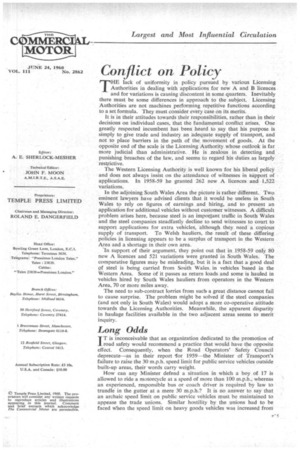Conflict on Policy
Page 31

Page 32

If you've noticed an error in this article please click here to report it so we can fix it.
THE lack of uniformity in policy pursued by various Licensing Authorities in dealing with applications for new A and B licences and for variations is causing discontent in some quarters. Inevitably there must be some differences in approach to the subject. Licensing Authorities are not machines performing repetitive functions according to a set formula. They must consider every case on its merits.
It is in their attitudes towards their responsibilities, rather than in their decisions on individual cases, that the fundamental conflict arises. One greatly respected incumbent has been heard to say that his purpose is simply to give trade and industry an adequate supply of transport, and not to place barriers in the path of the movement of goods. At the opposite end of the scale is the Licensing Authority whose outlook is far more judicial than administrative. He is zealous in detecting and . punishing breaches of the law, and seems to regard his duties as largely restrictive.
The Western Licensing Authority is well known for his liberal policy and does not always insist on the attendance of witnesses in support of applications. In 1958-59 he granted 262 new A licences and 1,522 variations.
In the adjoining South Wales Area the picture is rather different. Two eminent lawyers have advised clients that it would be useless in South Wales to rely on figures of earnings and hiring, and to present an application for additional vehicles without customer witnesses. A difficult problem arises here, because steel is an important traffic in. South Wales and the steel companies steadfastly decline to send witnesses to court to support applications for extra vehicles, although they need a copious supply of transport. To Welsh hauliers, the result of these differing policies in licensing appears to be a surplus of transport in the Western Area and a shortage in their own area.
'In support of their argument, they point out that in 1958-59 only 80 new A licences and 521 variations were granted in South Wales. The comparative figures may be misleading, but it is a fact that a good deal of steel is being carried from South Wales in vehicles based in the Western Area. Some of it passes as return loads and some is hauled in vehicles hired by South Wales hauliers from operators in the Western Area, 70 or more miles away.
The need to sub-contract lorries from such a great distance cannot fail to cause surprise. The problem might be solved if the steel companies (and not only in South Wales) would adopt a more co-operative attitude towards the Licensing Authorities. Meanwhile, the apparent disparity in haulage facilities available in the two adjacent areas seems to merit inquiry.
Long Odds
IT is inconceivable that an organization dedicated to the promotion of road safety would recommend a practice that would have the opposite effect. Consequently, when the Road Operators' Safety Council deprecate—as in their report for 1959—the Minister of Transport's failure to raise the 30 m.p.h. speed limit for public service vehicles outside built-up areas, their words carry weight.
How can any Minister defend a situation in which a boy of 17 is allowed to ride a motorcycle at a speed of more than 100 m.p.h., whereas an experienced, responsible bus or coach driver is required by law to trundle in the gutter at a mere 30 m.p.h.? It is no answer to say that an archaic speed limit on public service vehicles must be maintained to appease the trade unions. Similar hostility by the unions had to be faced when the speed limit on heavy goods vehicles was increased from 20 m.p.h. to 30 m.p.h., but it was not allowed indefinitely to stand in the way of a desirable reform. It is a poor• government that allows itself to be ruled by sectional interests.
Speed in itself is not dangerous. It becomes a menace only when it is used at the wrong time and place by the inexperienced and the selfish. Coach and bus drivers are among the finest in the country and their vehicles are the best maintained on the roads. They may be relied upon not to abuse the right to travel at, say, 50 m.p.h. outside built-up areas.
If the Minister cannot screw up the courage to make this obviously reasonable concession outright, let him raise the speed limit experimentally. After a year, statistics of accidents could be compared with those of the last 12 months in which a 30 m.p.h. limit applied. If there were a substantial increase in accidents involving public service vehicles, the concession could quickly be withdrawn. In fact, the Minister would be betting on a certainty and the Road Operators' Safety Council would undoubtedly be willing to give him short odds.
. . . . Even Odder
NOTHER absurdly anomalous situation which the .n.Minister should clear up concerns the licensing of light vehicles of the type used by various craftsmen to carry their equipment. The number of inquiries received by The Commercial Motor on this subject has been constantly high for many years (see page 704), and the recent remarks of Mr. R. E. G. Brown, reported in the May 27 issue, were amply justified.












































































































